*** Special to The BRAD BLOG's D.C. Correspondent, Margie Burns
Washington, D.C. -- U.S. District Court Judge Henry H. Kennedy held a hearing this morning on a motion filed by attorneys representing detainees being held in Guantanamo. Following reports in the New York Times and the Washington Post that CIA videotapes of ‘harsh interrogations’ of detainees had been destroyed, apparently by the CIA, possibly under administration approval, attorneys David Remes and Marc Falkoff filed an Emergency Motion [PDF] for inquiry into the preservation of documents relating to prisoners being held at Guantanamo Bay.
Before Judge Kennedy and a courtroom packed with journalists,
• Lawyers for the detainees are asking the court to schedule a hearing for inquiry into whether the government is preserving evidence relating to detainees. Attorney David Remes expressed concern that the destruction of the two videotapes, as reported, may not be the full extent of the evidence destroyed...
Remes also argued that any litigant, including the government, has an obligation to preserve evidence, and that Judge Kennedy issued an order on June 10, 2005, requiring respondents to “preserve and maintain all evidence and information regarding the torture, mistreatment, and abuse of detainees now at ... Guantanamo.”
• Lawyers for the government argued that the destroyed videotapes were not covered by the court’s order, because the order pertained only to Guantanamo, and petitioners have not proved that the detainees depicted in the videotapes were in Gitmo at the time of the court order.
The government also asked the court to stay its hand because of an ongoing DoJ investigation of the destruction of the videotapes. Also, DoJ attorneys contend that Judge Kennedy’s court does not have jurisdiction.
Following testimony before Congress by CIA Director Hayden, both WaPo and NYTimes reported on December 7 that two CIA videotapes depicting the torture of two detainees had been destroyed. Attorney John Dean of Watergate fame, now a regular columnist for Findlaw, estimates in a lucid article that at least 10 separate investigations are underway in this matter, among all three branches of our government.
The judge had strict questions for both sides:
Kennedy reminded government respondents that they hold that his court does not have jurisdiction over the underlying matter, a position upheld by the D.C. appeals court, though the Supreme Court has accepted cert., meaning that the high court will rule on the question. – Does your position mean, Kennedy asked government attorneys, that this court does not have jurisdiction to enforce or to inquire about destruction of evidence?
Also, the judge asked, you have requested that this court stay inquiry because of the DoJ investigation conducted by Kenneth Wainstein. But if Wainstein concurs that this court lacks jurisdiction, will there be a report from the DoJ investigation that will be shared with this court? The judge also asked, since the government is holding that there has been no violation of the prior order about preserving records, is the government willing to assure this court that it will pursue the matter, if it finds otherwise?
N.b.: In light of the administration track record on investigating its own, David Remes for the petitioners, a few minutes later, called the DoJ inquiry “leaving the fox in charge of the henhouse.”
The judge asked the petitioners, specifically, what form of inquiry do you seek? What does this inquiry hope to accomplish?
Remes answered, in response to questions, that petitioner is not assuming the destruction of evidence, but he said, “we assume that the government’s destruction [of the videotapes] raises a concern” about other evidence, giving the example of another client, a detainee named Hassen, said to be pointed out to CIA by “a senior al-Qaeda individual.” Who is this ‘senior al-Qaeda individual,’ Remes asked, and how was this information obtained? Could it too have been a product of torture? The destruction of the videotapes might mean further spoliation of evidence.
Putting today’s argument in the simplest terms: The government presentation consistently attempted to put Gitmo into one picture and the destroyed CIA videotapes into a totally different picture. Totally, emphatically separate pictures.
DoJ attorney Jody (Joseph) Hunt, speaking for the five attorneys seated at the Defense table, called it “inconceivable,” a word he repeated, that the destroyed videotapes could relate to detainees at Guantanamo.
Hunt stated that:
- The destroyed videotapes depicted only two detainees. [What information provides the basis for these claims was not stated in court.]
- The two detainees depicted in the videotapes were captured in March 2002 and November 2002, respectively.
- The videotapes were not created at Gitmo.
- The tapes were destroyed “in their entirety”, before the two detainees depicted in them were recorded as having been transferred to Gitmo.
This is where it gets dodgy, or, somewhat murky anyway.
As Remes pointed out in the courtroom, and afterward in answering questions from reporters, the government has not actually denied that the detainees were at Guantanamo. The government has not denied that the detainees were tortured there. The government has not denied that it violated the court order protecting the tapes. Remes remarked, more than once, that the government has given only a “non-denial denial.”
“Detainees have been transferred back and forth” more than once, Remes added in remarks to reporters afterward, and the government has put the entire burden of proof on petitioners, to show where the detainees were, and when.
Given government secrecy and concealment, and now destruction of key evidence, it is difficult to see how any petitioners could connect all the dots on detainee whereabouts without information from the government.
The government, in this matter of the destroyed videotapes, has stated that the two detainees depicted were transferred to Guantanamo in 2006, when George W. Bush proclaimed that detainees were being moved from secret prisons abroad into a place where they could be dealt with by military commissions. But the government has not established, or stated, that this 2006 transfer was the only time the two torture victims went to Guantanamo.
The entire case against 11 clients of his in Guantanamo, Remes said, and against scores of others, rests on interrogation records. Government destruction of the tapes raises questions about preservation of other evidence.
In Q and A for broadcast media, at the front entrance to the courthouse, Remes reiterated his prior statements. We do not know when the detainees first went to Guantanamo.
Given the insistence, at the Defense (govt) table, on painting Gitmo and the place where the videotapes were created (rumored to be Romania)m as two separate places, and maybe two separate universes, it would be useful for the public to know more about any links between the two:
- Setting aside prisoners for the moment, were any government personnel transferred back and forth between the two places, Guantanamo and maybe-Romania?
- What kind of communication was there, if any, between where the interrogations were videotaped, and Guantanamo?
I asked Remes whether the government has established, or has even argued, that the transfer of the detainees to Guantanamo had nothing to do with the interrogations on the tapes, with the videotaping, or with the destruction of the tapes? He answered, “I haven’t seen the government address that issue.”
So the government is arguing that these videotapes have nothing to do with Guantanamo, and that the transfer of the videotaped (and tortured) individuals to Guantanamo does not connect the two locations. The government has not yet confirmed or denied whether the transfer was connected to the aforementioned interrogations.
Murky enough for you? That may well be the point.
Meanwhile, as mentioned, any government case against the detainees, where they have one, rests on interrogations...for which there may, or may not be, videotaped documentation.
(Thanks to the Covington & Burlington law firm, where Remes is a partner, for copies of the filings given to journalists at Prettyman Courthouse, including this reporter. Thanks to the Jurist web site for scanning it.)


 Sunday 'Now Hoarding' Toons
Sunday 'Now Hoarding' Toons Mad World:
Mad World: 'Green News Report' 5/15/25
'Green News Report' 5/15/25
 Plane Corruption and the Future of the DOJ: 'BradCast' 5/14/25
Plane Corruption and the Future of the DOJ: 'BradCast' 5/14/25 'Deeply Evil': GOP Proposes Largest Medicaid Cuts in History: 'BradCast' 5/13/25
'Deeply Evil': GOP Proposes Largest Medicaid Cuts in History: 'BradCast' 5/13/25 'Green News Report' 5/13/25
'Green News Report' 5/13/25 And Then They Came for the Mayors...: 'BradCast' 5/12/25
And Then They Came for the Mayors...: 'BradCast' 5/12/25 Sunday 'New Guy, Old Guy' Toons
Sunday 'New Guy, Old Guy' Toons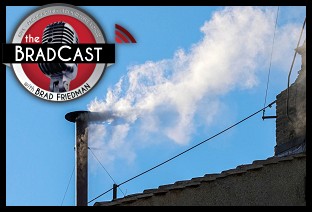 Blowing Smoke. At the Vatican and White House: 'BradCast' 5/8/25
Blowing Smoke. At the Vatican and White House: 'BradCast' 5/8/25 'Green News Report' 5/8/25
'Green News Report' 5/8/25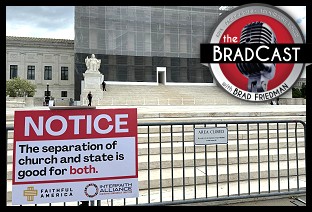 SCOTUS Weighs Public Funding of Religious Schools: 'BradCast' 5/7/25
SCOTUS Weighs Public Funding of Religious Schools: 'BradCast' 5/7/25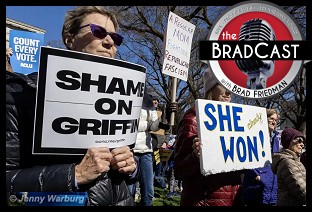 Trump Judge Blocks NC GOP Theft of 2024 Supreme Court Seat: 'BradCast' 5/6/25
Trump Judge Blocks NC GOP Theft of 2024 Supreme Court Seat: 'BradCast' 5/6/25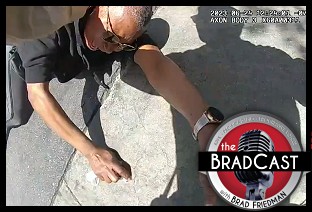 Prosecutors Quit After U.S Attny Strikes Deal With Felon Cop: 'BradCast' 5/5/25
Prosecutors Quit After U.S Attny Strikes Deal With Felon Cop: 'BradCast' 5/5/25 Trump Losing Streak Continues into SECOND Hundred Days: 'BradCast' 5/1/25
Trump Losing Streak Continues into SECOND Hundred Days: 'BradCast' 5/1/25 100 Daze (w/ Digby and Driftglass): 'BradCast' 4/30/25
100 Daze (w/ Digby and Driftglass): 'BradCast' 4/30/25 Campaign to 'Impeach Trump Again' Gains Fresh Momentum: 'BradCast' 4/29/25
Campaign to 'Impeach Trump Again' Gains Fresh Momentum: 'BradCast' 4/29/25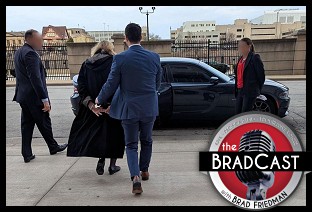 And Then They Came for the Judges...: 'BradCast' 4/28/25
And Then They Came for the Judges...: 'BradCast' 4/28/25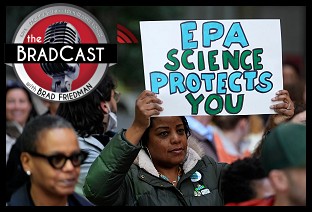 Trump EPA Guts Enviro Justice Office: 'BradCast' 4/24/25
Trump EPA Guts Enviro Justice Office: 'BradCast' 4/24/25
 VA GOP VOTER REG FRAUDSTER OFF HOOK
VA GOP VOTER REG FRAUDSTER OFF HOOK Criminal GOP Voter Registration Fraud Probe Expanding in VA
Criminal GOP Voter Registration Fraud Probe Expanding in VA DOJ PROBE SOUGHT AFTER VA ARREST
DOJ PROBE SOUGHT AFTER VA ARREST Arrest in VA: GOP Voter Reg Scandal Widens
Arrest in VA: GOP Voter Reg Scandal Widens ALL TOGETHER: ROVE, SPROUL, KOCHS, RNC
ALL TOGETHER: ROVE, SPROUL, KOCHS, RNC LATimes: RNC's 'Fired' Sproul Working for Repubs in 'as Many as 30 States'
LATimes: RNC's 'Fired' Sproul Working for Repubs in 'as Many as 30 States' 'Fired' Sproul Group 'Cloned', Still Working for Republicans in At Least 10 States
'Fired' Sproul Group 'Cloned', Still Working for Republicans in At Least 10 States FINALLY: FOX ON GOP REG FRAUD SCANDAL
FINALLY: FOX ON GOP REG FRAUD SCANDAL COLORADO FOLLOWS FLORIDA WITH GOP CRIMINAL INVESTIGATION
COLORADO FOLLOWS FLORIDA WITH GOP CRIMINAL INVESTIGATION CRIMINAL PROBE LAUNCHED INTO GOP VOTER REGISTRATION FRAUD SCANDAL IN FL
CRIMINAL PROBE LAUNCHED INTO GOP VOTER REGISTRATION FRAUD SCANDAL IN FL Brad Breaks PA Photo ID & GOP Registration Fraud Scandal News on Hartmann TV
Brad Breaks PA Photo ID & GOP Registration Fraud Scandal News on Hartmann TV  CAUGHT ON TAPE: COORDINATED NATIONWIDE GOP VOTER REG SCAM
CAUGHT ON TAPE: COORDINATED NATIONWIDE GOP VOTER REG SCAM CRIMINAL ELECTION FRAUD COMPLAINT FILED AGAINST GOP 'FRAUD' FIRM
CRIMINAL ELECTION FRAUD COMPLAINT FILED AGAINST GOP 'FRAUD' FIRM RICK SCOTT GETS ROLLED IN GOP REGISTRATION FRAUD SCANDAL
RICK SCOTT GETS ROLLED IN GOP REGISTRATION FRAUD SCANDAL VIDEO: Brad Breaks GOP Reg Fraud Scandal on Hartmann TV
VIDEO: Brad Breaks GOP Reg Fraud Scandal on Hartmann TV RNC FIRES NATIONAL VOTER REGISTRATION FIRM FOR FRAUD
RNC FIRES NATIONAL VOTER REGISTRATION FIRM FOR FRAUD EXCLUSIVE: Intvw w/ FL Official Who First Discovered GOP Reg Fraud
EXCLUSIVE: Intvw w/ FL Official Who First Discovered GOP Reg Fraud GOP REGISTRATION FRAUD FOUND IN FL
GOP REGISTRATION FRAUD FOUND IN FL

































